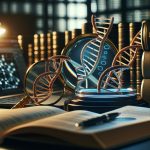At the forefront of innovation in biotech, American Gene Technologies (AGT) is paving the way with groundbreaking advancements that expedite the discovery of new treatments and cures within gene therapy. The brain behind this visionary enterprise, Jeff Galvin, not only leads as CEO but also shares his critical insights into the obstacles faced during drug development. Furthermore, he casts a hopeful gaze toward what lies ahead in medical science.
Delving deep into these discussions reveals a landscape rife with hurdles yet brimming with potential. For one, navigating through the intricate process of bringing drugs from concept to market proves to be a formidable challenge. Yet, it’s precisely these challenges that drive AGT’s mission forward. In essence, by harnessing cutting-edge technology and innovative approaches, they are not just partaking in the present-day scientific dialogue but are actively shaping what future medicine could look like.
Indeed, Jeff’s vision extends beyond mere participation; it’s about revolutionizing how we approach healing altogether. As daunting as the journey seems—with its technical complexities and regulatory mazes—it’s clear that AGT stands at an exciting crossroads of possibility and promise for advancing human health profoundly.
What projects is American Gene Technologies currently focusing on?
At the forefront of our research, we’re making strides toward developing an effective treatment for HIV. This groundbreaking initiative is currently undergoing clinical trials, showing promising preliminary results that suggest we’re on the cusp of achieving a significant breakthrough in curing this disease. The positive data collected so far fuels our optimism, suggesting that victory against HIV might be just around the corner within the scope of these ongoing studies.
Turning our attention to genetic disorders, our focus also includes tackling monogenic diseases like phenylketonuria – a rare condition predominantly found in the Middle East but also affects children in Europe and the United States at notable rates. Our innovative approach involves gene replacement therapy which shows great promise in alleviating the lifelong challenges faced by individuals with this hereditary disorder.
In addition to these efforts, one of our cutting-edge immuno-oncology developments promises to revolutionize cancer treatment by harnessing your body’s Gamma Delta T-cells. These cells are remarkable for their ability to distinguish between healthy tissue and malignancies, targeting and eliminating solid tumors characteristic of several types of cancer without harming surrounding tissues. Our pioneering therapy has demonstrated compelling success in preclinical trials involving mice with advanced-stage cancers, hinting at its potential efficacy in humans when applied to combat deadly solid tumors.
Our ambition doesn’t stop there; AGT stands out not just for its innovative DNA modification techniques aimed at improving health outcomes but also for offering a diverse array of tools unmatched by any other company globally. This comprehensive platform positions us uniquely to quickly and efficiently tackle new diseases, aspiring to produce novel therapeutics more cost-effectively and swiftly than ever before.
For those eager to learn more about AGT‘s mission and advancements, we invite you to check out a brief video introduction that offers further insights into how we’re paving the way towards transformative healthcare solutions.
Exploring the uses of gene and cell therapy
Breakthroughs in gene and cell therapy are revolutionizing the treatment of several once incurable diseases. Among these medical miracles is the innovative use of CAR-T therapy for acute myeloid leukemia and lymphoid leukemia, which has shifted outcomes from fatal to hopeful, with a significant percentage now curable.
An astonishing advancement comes in treating children born without immune systems due to ACA skin. Through either bone marrow transplants or genetic correction, these young patients gain functioning immune systems. Imagine kids who used to live their lives in sterile environments to avoid lethal infections, now playing and interacting freely outside their former confines.
Another remarkable success story is the restoration of sight for individuals blinded by Leber congenital amaurosis. By replacing a deficient gene within the eye, this therapy has turned darkness into light for many, enabling activities like hitting baseballs or driving cars that were previously unimaginable.
Spinal muscular atrophy has also seen groundbreaking progress. A malady that prevented children from performing basic movements such as lifting their heads or walking—and often led to early death—is now being countered effectively with new drugs developed by companies like AveXis. This transformation offers not just years but decades of life where before there was little hope.
Leukemias too have found their nemesis in CAR-T cell therapy, transforming a once grim prognosis into one where recovery is possible for 60-80% of cases treated; an unfathomable statistic just years ago.
At the heart of these innovations is not just science but human triumph—stories of overcoming insurmountable odds through ingenuity and perseverance. Companies like AGT are at the forefront, striving to streamline drug development processes and bring more cures from lab benches into real-world application faster than ever before.
How does it vary from today’s Western medicine?
In the realm of medicine, the traditional approach has always involved treatments that are somewhat akin to using a sledgehammer to crack a nut. Pills and injections tend to scatter medication throughout the body, impacting not just the problematic cells but also those that are perfectly healthy. This broad-brush method can lead to unwanted side effects because some cells get hit with medication they don’t actually need. In certain cases, doctors have had to dial back on dosage or dismiss a potentially effective drug altogether due to its adverse effects on crucial cells—a situation far from ideal.
Enter the groundbreaking field of gene and cell therapy. Imagine being able to fine-tune our bodies at the cellular level, much like downloading an update for your computer. This innovative approach allows scientists to precisely target only the affected cells, leaving the healthy ones untouched and free from harm. It’s as if we’re transforming viruses into helpful updates for our bodies by replacing or repairing faulty genes responsible for diseases.
A vivid example is treating conditions caused by missing or defective genes—like phenylketonuria, which results from a lack of a specific gene. Our bodies work according to instructions provided by sequences of amino acids and nucleotides in our DNA. Nowadays, with advancements in science, obtaining any human or synthetic gene is as easy as placing an online order; it arrives ready for action.
The process involves repurposing viruses by removing their harmful components and inserting therapeutic genes instead. These modified viruses then become delivery vehicles specifically designed to target diseased cells without affecting others. They’re attracted only to cells with certain receptors—akin to how COVID targets cells with ACE2 receptors in the respiratory tract.
What’s more intriguing is how this technology doesn’t just stop at delivering treatment; it can intelligently determine whether a cell requires intervention based on its internal environment—an ‘if-then’ mechanism activated only in presence of disease markers within targeted cells.
This smart way of treating diseases marks a significant step forward from conventional medicine’s scattergun approach. It offers hope for isolating treatment effects solely on diseased cells while sparing healthy ones—the ultimate precision tool in our medical arsenal against inherited disorders and potentially many other ailments too.
What’s new about your HIV treatment?

HIV cleverly attacks the body’s T-cells, which are crucial for our immune response. To counter this, scientists have developed a groundbreaking method using a specialized lentiviral vector to fortify these T-cells against HIV. This innovation marks a significant leap forward, transforming ordinary T-cells into invincible warriors capable of eliminating the virus from our bodies.
A small fraction of individuals naturally resist HIV due to a genetic anomaly that prevents the virus from taking hold. In contrast, most people lack this mutation and are vulnerable to infection if the virus encounters their T-cells. Once infected, these cells turn traitor instead of defending us, multiplying and spreading HIV throughout the body.
Interestingly, when it comes to dealing with common colds, our bodies function exactly as intended. The immune system mobilizes unaffected T-cells to annihilate the invading viruses and replicate to bolster our defenses against future assaults.
By applying this protective strategy specifically against HIV, researchers have unlocked the potential for making individuals permanently resistant to the virus in much the same way as we naturally fend off colds.
The recent research collaboration with Anthony Fauci and his team at the National Institute of Allergies and Infectious Diseases has resulted in promising findings that suggest this approach may effectively cure HIV infections.
Current treatments for HIV involve antiretroviral therapies (ART), which come with a host of unpleasant side effects ranging from nausea and fatigue to serious long-term health issues such as bone weakening or heightened cancer risk.
The advent of AGT’s cell therapy treatment, however, heralds a new era where those living with HIV can look forward to life without daily medication regimens or fear of transmitting the disease. For many, it offers more than just physical relief; it promises an unprecedented return to normalcy – freedom from AIDS forever.
Does the COVID vaccine function this way?
The COVID vaccine operates on a principle similar to experiencing the illness without the actual sickness. It sends a fake alarm of infection to your body, gearing it up against the real deal without causing any harm. This prep work is crucial; it ensures that if the actual virus dares to invade, our bodies are ready to throw down and defend themselves effectively.
At the heart of this innovative defense strategy lies mRNA technology. Scientists pinpointed a specific part of the virus – known as the spike protein – that’s essentially harmless yet recognizable by our immune system. They then crafted tiny fat droplets, or lipid nanoparticles, to carry instructions for creating this spike protein directly into our cells.
Once inside, these instructions get straight to work. Our muscle cells, mistaking these particles for nutrients due to their fatty exterior, consume them eagerly. This process unveils the mRNA which then commands our cells to produce spike proteins. As these proteins accumulate at the injection site, typically your shoulder area, they kickstart an immune response as if COVID itself has made an entrance. The body’s defenders rush in and memorize how to tackle this threat – a rehearsal for encountering the genuine virus.
This preemptive strike offers several advantages over letting nature take its course. Primarily, it spares us from feeling sick since our immune system isn’t caught off guard by the real virus. More importantly, it shields us from severe outcomes like lung or nerve damage that can accompany uncontrolled viral infections.
In essence, getting vaccinated is akin to undergoing a trial run: it primes your immune system so well that when faced with COVID for real, you might not even notice it’s there, all while dodging potentially life-threatening complications.
Challenges in making gene and cell therapy uniform and solutions to these problems
In a world where progress is constant, the frontiers of medicine are expanding in ways we once thought belonged in science fiction. With each passing year, groundbreaking advances in gene and cell therapy signal a future where healing comes not from traditional methods but through control at the cellular level. This revolution closely mirrors the trajectory of the computer industry, which saw exponential increases in power paired with decreasing costs.
Much like updating software to enhance a computer’s performance, gene and cell therapies offer upgrades to our biological systems, targeting illnesses directly at their genetic roots. The pace at which these treatments are improving is nothing short of astounding, doubling their capabilities while becoming more affordable with time. This shift promises a seismic change in healthcare availability worldwide, transforming once-incurable diseases into manageable conditions.
The early days of such medical breakthroughs come with steep price tags, accessible only to those with ample resources or comprehensive insurance plans—a scenario reminiscent of the early computing era when owning a powerful mainframe was beyond most people’s reach. Yet just as computers evolved from luxury items to everyday essentials across the globe, so too will advanced medical treatments eventually extend their reach to all corners of society.
The principle driving this transformation is akin to Moore’s Law—the observation that computing power doubles approximately every 18 months without an increase in cost—which has held true for decades within the tech sector. Now biotechnology is riding a similar curve; advancements such as genome sequencing have seen costs plummet even faster than anticipated by traditional projections.
This rapid evolution underscores technology’s role as both catalyst and foundation for modern biotech achievements. The development and distribution of COVID-19 vaccines underscore this point vividly; what previously took years was accomplished in mere weeks due to technological innovations, although safety testing extended that timeline significantly.
Ultimately, technology marches on unabated—refined over time by continuous innovation and discovery—ushering an era where barriers to health equity begin crumbling under its advance. It’s not just about curing diseases anymore but reimagining healthcare accessibility for humanity itself.
What’s your view on biotech’s future?
As we delve deeper into the world of genetics, our understanding of human biology expands, enabling us to tweak and improve our bodies with increasing precision. This growing body of knowledge paves the way for innovative solutions that can accelerate progress in health sciences like never before.
In time, it’s expected that we will have a comprehensive grasp on the roles played by genes, proteins, and enzymes within our system. This could lead to an era where simulating entire human bodies on computers becomes commonplace, drastically reducing the need for traditional drug testing methods. The Food and Drug Administration (FDA) might one day rely on these simulations to pinpoint areas needing real-world testing while confidently bypassing others.
Imagine a scenario where computers swiftly analyze data from three billion genetic sequences in just a single day—a feat that is anticipated to be possible within two decades. While some direct clinical trials may remain necessary for those elements not fully understood through data and simulations, their scope would be significantly narrowed down.
If you think this sounds overly optimistic, consider how revolutionary ideas about technology were received in the past—for instance, predictions made back in the 1970s about computers managing manufacturing processes or even driving cars seemed far-fetched then but are reality today. Following this trajectory suggests a future where advanced computer simulations become integral to medical research.
Fifteen years ago, AGT was founded with an ambitious vision for advancing biotechnology. Today, AGT stands at the forefront of its field because it approaches challenges with an innovative mindset and has developed capabilities surpassing those of many competitors. AGT‘s ongoing mission is clear: leverage cutting-edge science to tackle diseases rapidly and effectively in order to alleviate suffering caused by serious health conditions.




















